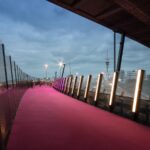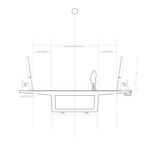Introduction
LightPathAKL, a collaborative project by Monk Mackenzie Architects and Landlab, has revitalized six hundred meters of disused highway infrastructure into a vibrant cycleway, crucially connecting Auckland’s inner city cycle network.

Repurposing Urban Infrastructure
Initiated as a response to a study highlighting the potential of a neglected highway offramp, LightPathAKL emerged as a solution to complete Auckland’s inner city cycle network. Architecturally, the project addressed both macro and micro scales, blending urban artistry with functional design.

Urban Artistry and Design
At the city scale, the project stands as a bold intervention, transforming an unused highway segment into a contemporary urban space. A striking pink resin and aggregate surfacing redefined the landscape, while over 300 LED light boxes along the cycleway’s edge created a dynamic light sculpture, enhancing the urban realm.

Cultural Integration
Crucially, Maori artist Katz Maihi contributed to infusing the project with cultural narrative and identity. Original artworks engraved on aluminium plates and integrated into the cycleway barrier, along with a bespoke artwork at the northern end, added depth and connection to the local context.
Redefining Urban Connectivity
LightPathAKL transcends conventional notions of urban connectivity, leveraging color, materiality, and technology to redefine movement within the city. With over 100,000 cycle journeys made on #LightPathAKL, the project has become an indispensable piece of Auckland’s cycling infrastructure.

Conclusion
LightPathAKL exemplifies the transformative power of design in reimagining urban spaces. By repurposing redundant infrastructure, integrating cultural elements, and prioritizing user experience, Monk Mackenzie Architects and Landlab have created a dynamic and inclusive environment that enriches Auckland’s urban fabric and fosters sustainable transportation options.













